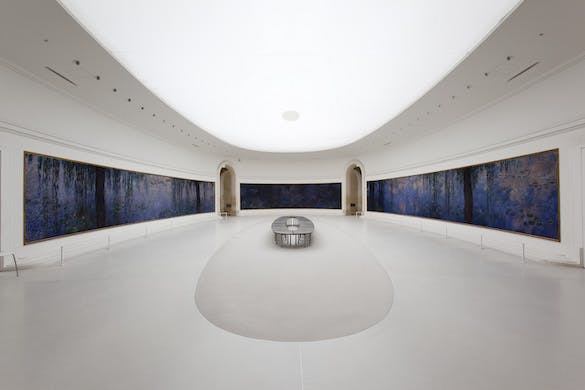Monet’s ‘Water Lilies’ Offer a Sea of Serenity in a War Ravaged World
Armistice Day is a moment to revisit these immersive works that envelop the modern eye in a sea of serenity.

Claude Monet’s “Nymphéas,” or “Water Lilies,” at the Musée de l’Orangerie at Paris, provide a rare moment of respite in a world ravaged by war.
“My wish is to stay always like this, living quietly in a corner of nature,” Monet once said of his garden at Giverny in northern France. Its luscious flora and Japanese-style pond inspired his more than 250 works in “Nymphéas” between 1897 and his death in 1926. As the painter wished, the permanent exhibit of his eight final panels, the “Grande Décoration,” requests that visitors “view this exceptional work in silence” so as to find “a space for reflection.”
While hushing their viewers, the panels envelop the eye in a sea of serenity. Stretching across 300 feet in two adjoining rooms, the near-seamless panoramic frieze intended to create an “illusion of an endless whole, of a wave with no horizon and no shore,” as an exhibit panel quotes Monet. “An astonishing painting,” critic Louis Gillet remarked at the exhibit’s opening in 1926. “Without pattern, without borders.”
This aesthetic immersion enthralls no less today. The average museum visitor latches eyes to a work of art for no more than 30 seconds. Monet’s canvases, though, render such restlessness impossible. Amid the swirls of blues and the shocks of lavender and yellow, the cardinal directions lose their relevance, the horizon line melts, and time and space become unknown.
Just as the paintings uplift, though, they also plumb the depths. Behind the pond’s pale ripples lies a midnight darkness. This is the dominant hue in the second room at the “Orangerie,” where bruises of blue and green become nearly indistinguishable in their dimness, conveying something of aquatic anguish. “Clammy and uncanny” is how one critic describes the works.
Monet’s biography can help explain this chiaroscuro shift in tone, outlined in a 2016 study of the works, “Mad Enchantment” by Ross King. When the 74-year-old artist picked up his brush for his final panels in 1914, his son and his wife had recently died. Most of his family members and friends, in a grand exodus, left Giverny when France entered World War I that year.
While Monet stayed behind, the war galvanized him to produce some of the most recognizable paintings of the 20th century. The day after the Armistice in 1918 — 105 years ago on Saturday — Monet pledged to offer his masterpiece to France and to sign it on Victory Day the following year. Created while the world was beset by brutality, the murals became a national symbol of peace.
“Water Lilies” left an indelible imprint on the art world. While the Impressionist movement he had helped lead 50 years earlier was on its descent, Monet’s “en plein air” paintings of his garden reinvented it in its most abstract form. No wonder he inspired the likes of Mark Rothko and Jackson Pollack, who cherished the strokes of the brush and the richness of the paint more than the figurative content of the canvas.
Monet summoned the public to trust in his conjuring of color and his call for silence. The half a million visitors to the “Orangerie” suggest that after a century, his water lilies show no sign of wilting.

